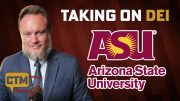
This is the sixth segment in a series on K-12 education. Although John Dewey, the originator of “progressive education,” defied most of the cultural, moral, and economic norms of his era, his message nevertheless somehow mainstreamed its way into K-12 schools nationwide. Dewey characterized himself as a “democratic socialist.” Over the years, his writings increasingly underscored an aversion to the free-market system; an abhorrence of religion, especially Christianity; a distaste for educational basics such as reading and writing; and finally, in 1928, an admiration for Soviet schooling — for the creation of what he called a “collectivistic mentality.” Given the traditionalistic norms of the 1920s and 30s, the likelihood of his affecting a sea change in education seemed about as likely as the United States replacing the Constitution with Shariah law. Then again, strange things happen, and not usually by chance.
Throughout Dewey’s voluminous writings, two themes recur: that education and learning are interactive processes, which had some basis, and that the school itself is a social institution through which social reform can and should take place, which paved the way for political opportunists. He averred that educational institutions should not be just places to gain knowledge, but places “where one learns how to live.” Because Dewey considered God and religion fantasies, perhaps it was unsurprising that he would commandeer the prerogatives of “Sunday School” and transfer them to institutions of learning. Dewey coined the term “functional psychology” to describe the key to existence in a complex society.
Like his mentor, German socialist philosopher Wilhelm Wundt, Dewey saw psychology as a rational alternative to “supernatural religion.” Toward that end, he was among the signers of the Humanist Manifesto in 1933. The switch from knowledge-based schooling to a psycho-social, reform-based model was the juncture when everything started going wrong with education. The heretofore inconspicuous contingent of American Communists seized upon psycho-social reform, ignoring other insights that Dewey proffered — many not unreasonable, such as striking a balance between delivering knowledge while also taking into account the interests and experiences of the student. Citing Dewey, they turned the nation’s schools into a political football steeped in the behavioral sciences instead of intellectual challenge.
A naïve Dewey and his ivory tower contemporaries envisioned a benevolent (as opposed to coercive) welfare state, with schools serving as concealed-in-plain-sight “agents of change,” poised to impose, through successive waves of graduating youth, a new social order on America within a generation or two at the most. These “change agents” were to sweep away the ideals of America’s Founders under the cover of modernism and progress — thus the term “progressivism.” Today’s modern dictionary assigns positive synonyms to “progressivism,” while “traditionalism,” “individualism,” and “conservatism” are depicted as backward.
Because most Americans were focused on the carnage of World War II, an emerging “mental health” cabal began speaking out, advocating a society indifferent to nationality, sovereignty, and bourgeois “morality.” Among such company, Dewey found a safe haven for his experiments, but was alarmed by what he considered the excesses of “child-centered” pedagogues who claimed to be his followers. He even argued that too much reliance on the child could be detrimental to the learning process. Using this line of reasoning, Dewey was ahead of his time in emphasizing “hands-on learning,” as opposed to teachers forever standing at the front of the room doling out information to passive pupils. He insisted that “it is impossible to procure knowledge without the use of objects which impress the mind.” That is why many credit him with the advent of Project Based Learning (PBL), which places students in the active role.
But in the hands of left-leaning opportunists, PBL wound up emphasizing learning as a strictly collective process, with individual ingenuity suddenly undesirable. When Dewey suggested that the teacher’s role should be that of “facilitator” and “guide,” the America left found its public-relations pitch. The cherry on the sundae was Dewey’s further comment that “[t]he Russian educational situation is enough to convert one to the idea that only in a society based upon the coöperative principle can the ideals of educational reformers be adequately carried into operation” (Chapter 5 in his book Impressions of Soviet Russia).
In 1935, the National Education Association became more vocal in an attempt to see how socialist rhetoric would sit with the public. At the NEA’s annual meeting, incoming NEA Secretary Willard Givens declared: “A dying laissez-faire must be completely destroyed, and all of us, including the ‘owners,’ must be subjected to a large degree of social control. … An equitable distribution of income will be sought.”
About the same time (1933), Louis Alber, head of National Recovery Act New York, announced: “The rugged individualism of Americanism must go, because it is contrary to the purpose of the New Deal … which is remaking America.”
These pronouncements fueled the determination of leftist leaders to ensure that parental rights and religious ideals were swallowed up, the prerogatives of local communities usurped, and a “controlled collective” imposed. With the exception of racial inequality, which was in the news 24/7, war-weary Americans had no clue as to any other pivotal shifts and policy reversals that might be occurring under their noses between 1946 and 1960. For example, Canadian psychiatrist Brock Chisholm’s challenge to the World Federation of Mental Health (reprinted, 1946 in Psychiatry Magazine):
We have swallowed all manner of poisonous certainties fed us by our parents, our Sunday and day school teachers… The results are frustration, inferiority, neurosis and inability to… make the world fit to live in. … The re-interpretation and eventually eradication of the concept of right and wrong which has been the basis of child training … these are the belated objectives of practically all effective psychotherapy….
And that was just a warm-up. By 1968, NEA president Elizabeth Koontz was alerting the American Association of Colleges for Teacher Education that the teachers’ union had “a multi-faceted program already directed toward the urban school problem, embracing every phase, from the Headstart Program to sensitivity training for adults — [aimed at] both teachers and parents.”
Then, a bolder move: In the early 1970s, NEA president George Fischer told the union’s annual assembly that “a good deal of work has been done to begin to bring about uniform certification controlled by the unified profession in each state…. With these new laws, we will finally realize our 113-year old dream of controlling who enters, who stays and who leaves the profession…. we can also control the teacher training institutions.”
Two years later, NEA president Catharine Barrett took an even more strident tack, declaring: “We are the biggest potential political striking force in this country, and we are determined to control the direction of education.” A year later, she called for “de-emphasizing academic basics in favor of teachers becoming philosophical ‘change agents’.”
It didn’t take long before the NEA Journal was endorsing the centerpiece of its strategy: “values clarification” — a catch-phrase coined by leftist educators as a stand-in for “affective-interactive educational psychology.” The groundwork was laid by psychologist Lawrence Kohlberg in his controversial 1963 Stages of Moral Development theory, aimed at supplanting “conventional morality.” With that, “progressive education” morphed into humanistic psychology and the “humanistic education movement” — an approach that discourages adults from transmitting the “right” values and, instead, “empowers” even small children to “develop their own valuing process.”
The 70s-era watershed book that made depravity, decadence, and self-indulgence part and parcel of the school environment was Values Clarification — A Handbook of Practical Strategies for Teachers and Students, based on the work of Louis Raths, Vera Harmon, Sidney Simon, Howard Kirschenbaum, and Leland Howe. It featured scenarios of manipulative values-changing aimed at speeding society’s transformation. Among the classroom exercises was Strategy #3: “values voting.” (Think “flash-mobs.”)
From there, progressivism moved quickly into an amoral humanist-socialist mode. The Soviet text called The Scientific and Technological Revolution and the Revolution in Education was translated and imported to the United States. It helped lay the foundation for a philosophy called Outcome-based Education, promulgated in America by William Spady. A 1988 NEA Journal published “The New Social Studies,” urging that American education — especially the university departments of teacher education — be reorganized “using materials from the behavioral sciences,” planting the tenets of social psychology firmly into elementary and secondary history classes.
Meanwhile, Ernest Boyer, president of Carnegie Foundation of the Advancement of Teaching (CFAT) pronounced that schools must be treated, not as “academic centers,” but as “social service centers,” providing day-long health-care (now called school-based health clinics), day-care for preschoolers (now termed early childhood education), and other social services, such as meals. John Goodlad had already seconded the notion in his 1976 tome, A Place Called School.
It wasn’t until parents began noticing an uptick in non-education-related data collection through quasi-educational school surveys and assessments, and blatant activities aimed at social engineering and promoting world government, that they started paying attention. They found more than they bargained for: among them (click on links to see their connections to curriculum), the Education Commission of the States; the Rockefeller Foundation; the Robert Wood Johnson Foundation; the Jane Fonda Center; the Sexuality Information and Education Council of the U.S. (SIECUS); the American Psychological Association; Global Education Associates; Greenpeace; and the American Humanist Association.
Among the most shameful was the Aspen Institute for Humanistic Studies, where a six-year-old orphaned refugee, Elián González — whose mother drowned in 1999 fleeing Communist Cuba — was torn from extended-family members at the point of a rifle under orders from then-U.S. Attorney General Janet Reno, to be re-educated into “collective thinking” before being handed back to Castro. But by the year 2000, the agenda was so complete that most news outlets simply referred to the place as the Aspen Institute, presumably a safe haven for a confused little boy.
By 1992, the White House was publicly onboard with progressive education. First Lady Hillary Clinton colluded with Marc Tucker, director of the National Center on Education and the Economy (an agency within the Carnegie Foundation) to administer a final coup — in Tucker’s words, “breaking the current system, root and branch.” Joy G. Dryfoos’s 1994 work, Full-Service-Schools, concurred, with an endorsement from Sen. Edward M. Kennedy, the real force behind the No Child Left Behind Act in 2001, not George W. Bush.
Thus did the “Progressive Movement” metastasize as humanistic psychology. A gullible public believed all they had to do was write their Representative and Senator to turn their schools around. They woefully underestimated. Outmaneuvered, parents either caved — school dances, sports, cheerleaders, “I only want my kids to be happy” — or they became a part of a homeschool resistance: directly in the crosshairs of a compromised and top-heavy government.
“Progressive” was now mainstream.
The seventh and final segment in this series will focus on how, and whether, schools can be fixed.
Article Series:
Part 1: Obama’s Early Learning Challenge and Our Failed Education System”
Part 2: Education Department Throws America’s Kids Under the Bus
Part 3: Obama’s “Common Core of Standards”: Final Step in Phony School Reform
Part 4: Tax Dollars Fuel Unlawful Nationalized Curriculum, Parent-Bypass
Part 5: George Washington: The Latest Casualty of Progressive Education
Part 7: An “Extreme Makeover” for U.S. Education — Can We? Should We?
_________
Beverly K. Eakman began her career as a teacher in 1968. She left to become a science writer for a NASA contractor, then editor-in-chief of NASA’s newspaper in Houston. She later served as a speechwriter and research-writer for the director of Voice of America and two other federal agencies, including the U.S. Dept. of Justice. She has since penned six books, scores of feature articles and op-eds covering education policy, mental-health, data-trafficking, science, privacy and political strategy. Her e-mail, a detailed bio, speaking appearances and links to her books all can be found on her website: BeverlyEakman.com.




